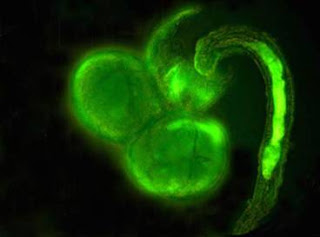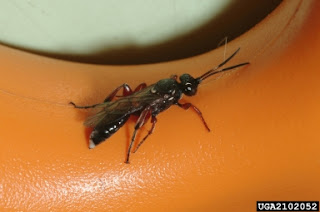Bear with us on this one...it might get a little complicated:
Wasps from the genus Copidosoma lay two eggs into a host egg (for example a moth or butterfly egg). One of these two eggs is male and one is female. The male and female larvae then begin multiplying--much like single celled organisms--into a thousand copies of themselves inside the egg. Thus the female "sisters" are more closely related to each other than they are to their brothers, and vice versa. The host egg, however, can only accommodate about half of the thousands of larvae now writhing around within it.
Congratulations! It's a girl. Female wasp larva (right) feasting on its brother (bundle of cells in the middle)
Some of the sister larvae are sterile, and though they cannot reproduce to pass along their genetic material, they CAN stop their brothers from doing so. How? You don't know? By transforming into a serpintine shape with over-sized jaws and eating their brothers alive while they're still just a bundle of cells. Duh.
Evolutionary biologist Andy Gardner of Oxford University explains, "Although the genes for this spiteful behavior find themselves at an evolutionary dead-end in the sterile larvae, copies of these genes are passed onto future generations because they are also present in the clonal sisters, who do survive and reproduce."
"Madeline J. Stingerstein, you stop ravenously feasting on your embryonic brother this instant or you will go to bed without supper this evening, young lady!" Encrytid wasp, Comperia merceti
digg_url='http://zooillogix.blogspot.com/2007/04/female-wasp-larvae-eat-their-bro…';